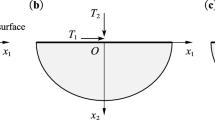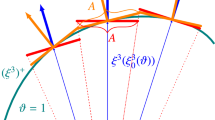Abstract
A three-dimensional finite element study of crack tip fields in thin plates under bending, shearing, and twisting loads is carried out to study the relation of the plate theory crack tip fields to the actual, three dimensional crack tip fields. In the region r>0.5h the Kirchhoff theory is a good approximation of the three dimensional stress fields for symmetric plate bending. The Reissner theory gives a good approximation in the region r<0.1h. Similar results are found for the shear and twisting problems, although for pure shear loading, the Kirchhoff theory is a good approximation somewhat farther r>h from the crack tip than in the bending problem. In the case of shear loading the near tip out-of-plane shear stresses do not vary quadratically through the thickness as in plate theory, but are nearly constant, except in the neighborhood of the free surface. Quadratic variation, as predicted by plate theory, is observed for r>h. Energy release rates based on the Kirchhoff and Reissner theories agree well with those computed by means of three dimensional finite element analyses.
Similar content being viewed by others
References
Alwar, R.S. and Ramachandran, K.N. (1983). Three-dimensional finite element analysis of cracked thick plates in bending. International Journal for Numerical Methods in Engineering 19, 293–303.
Benthem, J.P. (1977). State of stress at the vertex of a quarter-infinite crack in a half-space. International Journal of Solids and Structures 13, 479–492.
Hui, C.Y. and Zehnder, A.T. (1993). A theory for the fracture of thin plates subjected to bending and twisting moments. International Journal of Fracture 61, 211–229.
Joseph, P. and Erdogan, F. (1991). Bending of a thin Reissner plate with a through crack. Journal of Applied Mechanics 58, 842–846.
Knowles, J.K. and Wang, N.M. (1960). On the bending of an elastic plate containing a crack. Journal of Mathematics and Physics 39, 223–236.
Levy, N., Marcal, P.V. and Rice, J.R. (1971). Progress in three-dimensional elastic-plastic stress analysis for fracture mechanics. Nuclear Engineering. Design 17, 64–75.
Nakamura, T. and Parks, D.M. (1988). Three-dimensional stress field near the crack front of a thin elastic plate. Journal of Applied Mechanics 55, 805–813.
Nakamura, T. and Parks, D.M. (1989). International Journal of Solids and Structures 25, 1411–1426.
Reissner, E. (1944). On the theory of bending of elastic plates. Journal of Mathematics and Physics 23, 184–194.
Reissner, E. (1945). The effect of transverse shear deformation on the bending of elastic plates. Journal of Applied Mechanics 12, A69–A77.
Reissner, E. (1947). On bending of elastic plates. Quarterly of Applied Mathematics 5, 55–68.
Rice, J.R. (1968). A path independent integral and the approximate analysis of starin concentration by notches and cracks. Journal of Applied Mechanics 35, 379–386.
Sanders, J.L. (1960). On the Griffith-Irwin fracture theory. Journal of Applied Mechanics 27, 352–353.
Sih, G.C., Paris, P.C. and Erdogan, F. (1962). Crack-tip stress-intensity factors for plane extension and plate bending problems. Journal of Applied Mechanics 29, 306–312.
Simmonds, J.G. and Duva, J. (1981). Thickness effects are minor in the energy release rate integral for bent plates containing elliptic holes or cracks. Journal of Applied Mechanics 48, 320–326.
Tamate, O. (1975). A theory of dislocations in the plate under flexure with application to crack problems. Technology Reports, TohokuUniversity 40, 67–88.
Timoshenko, S. and Woinowsky-Krieger, S. (1959). Theory of Plates and Shells. McGraw-Hill, New York.
Viz, M.J., Zehnder, A.T. and Bamford, J.D. (1995). Fatigue fracture of thin plates under tensile and transverse shear stresses. In: Fracture Mechanics (Edited by Reuter et al.), Vol. 26, ASTM STP 1256, Philadelphia, PA, 631–651.
Viz, M.J., Zehnder, A.T. and Potdar, Y.K. (1999). Fatigue fracture in plates in tension and out-of-plate shear. Fatigue and Fracture of Engineering Materials and Structures (accepted).
Wang, N.M. (1970). Twisting of an elastic plate containing a crack. International Journal of Fracture Mechanics 6, 367–378.
Williams, M.L. (1961). The bending stress distribution at the base of a stationary crack. Journal of Applied Mechanics 28, 78–82.
Young, M.J. and Sun, C.T. (1993). On the strain energy release rate for a cracked plate subjected to out-of-plane bending moment. International Journal of Fracture 60, 227–247.
Young, M.J. and Sun, C.T. (1993). Cracked plates subjected to out-of-plane tearing loads. International Journal of Fracture 60, 1–18.
Zehnder, A.T. and Hui, C.Y. (1994). Stress intensity factors for plate bending and shearing problems. Journal of Applied Mechanics 61, 719–722.
Author information
Authors and Affiliations
Rights and permissions
About this article
Cite this article
Zucchini, A., Hui, C. & Zehnder, A.T. Crack tip stress fields for thin, cracked plates in bending, shear and twisting: A comparison of plate theory and three-dimensional elasticity theory solutions. International Journal of Fracture 104, 387–407 (2000). https://doi.org/10.1023/A:1007699314793
Issue Date:
DOI: https://doi.org/10.1023/A:1007699314793




